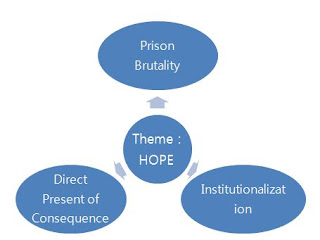Ye Ji Park / 111053 / 6
Mr.Garrioch
English Composition
October 26 2011
Comparison Journal: Shawshank Redemption, Novella and Film
Once a novel achieves stupendous success, movie companies scramble to get the contract of filming the book. Considerable numbers of movies are filmed after books; representatives are Harry Potter Series, Twilight Saga, Lord of the Rings, etc. Still, quite many movies are evaluated to be weak, shabby, and inferior to original novels. Major reasons are time constraint and commercial viability. The failure of Harry Potter movies is a great example; for time constraint, the directors had to delete detailed scenes to finish the movie in two hours. The film, then, provided only general flow of the plot, thereby disappointing viewers who were memorizing even the specific lines of the book. In case of commercial viability, the directors added extra scenes emphasizing the love or sexual relationship between characters to arouse viewers. Likewise, since the directors pervert the novel’s original message by deleting or adding inappropriate scenes, movies are usually less influential than books.
But the movie Shawshank Redemption, filmed after Stephen King’s novella Rita Hayworth and Shawshank Redemption, is an exceptional. Film producers modified the novella, but in proper way. They did grasp the theme of novella, and excluded or included scenes that could contribute in conveying the theme effectively, maybe more effectively than the book. Still, the film did not forget about entertaining elements; modified details created dramatic atmosphere.

First, the theme. Before illustrating what specific scenes the movie added or omitted, the novella’s theme should be defined clearly. In Different Seasons, the collection of King’s four novellas, Rita Hayworth and Shawshank Redemption is introduced as the chapter “HOPE, SPRINGS, ETERNAL”. The first word of chapter title shows the novella’s theme evidently; hope. To be specific, it is a story about “patience, hope, survival, emancipation, and ultimate redemption and salvation”.1)
There are three factors that contributed in bringing hope into relief. First is prison violence; prison’s harsh punishment given to deviated prisoners (representatively, breakout attempts) disturbs prisoners to keep hope. As more as the prison’s desolateness is emphasized, the hope Andy had kept so persistently is valued higher. The movie caught this point precisely, and modified the movie to emphasize prison brutality. In the introductory part – Andy’s first day in Shawshank – the film added a new character, fatty guy. On his first night, the fatty guy was mocked by other prisoners, cried out loud and made a great disturbance. Prison guards, maddened, exerted violence on this guy so harsh that he died next morning. This incident proved the severe violence in Shawshank. How Warden Norton dealt with Tommy is another good example; Tommy was a character who might be able to prove Andy’s innocence, but Norton did not wish to let Andy, a fine banker, leaves Shawshank. As solution, Norton compromised with Tommy and sent him to a better prison in the book, but in the film, Norton shot Tommy to keep his mouth shut. Without doubt, killing is a better way to show human brutality than compromising.
Second factor emphasizing hope is “institutionalization”. Even though the environment is dreary (prison guards cussing and beating), prison has its routine schedule, and prisoners do not need to worry about their life. But once prisoners get parole and return to the society, they confront unpredictable events and miss monotonous prison life. The concept is emphasized in the movie as the paroled prisoner named Brooks fails to adjust to the society and commits suicide – that is, Brooks was so institutionalized that he voluntarily chose to die than to live in the society. Andy also suffered some institutionalization; he lingered after he completed digging, instead of immediate escape. Still, at the end, he broke out; this emphasizes his strong will toward hope to freedom, abandoning predictable, accustomed lifestyle.
Final factor of showing hope is the direct presentation of hope’s consequence. The book finishes with Red’s monologue to hope meeting Andy, while the movie includes the scene Red and Andy meet. This direct scene shows the fulfillment of Red’s hope, and creates hopeful atmosphere.
Entertaining aspects of the movie also deserve to be praised. While the book did not mention about the rock hammer’s whereabouts, the movie showed Andy hided it in the Bible. Such dramatic scene was shocking and surprising to the viewers. Similarly, the movie’s content that Andy took away Norton’s bribed money and revealed corruption in Shawshank was also a fresh shock. These fractions helped the viewers to enjoy the film.

In short, the film is a total success since it contributed in elaborating the theme, and also paid attention to entertaining purpose. It seems to me the directors of Shawshank Redemption are very intelligent and witty people; they precisely comprehend the message Stephen King tried to convey through the novella, and developed it by adding dramatic elements. It’s always happy to meet these directors and their films – those who are truly “after the book”, truly revere the original text, instead of those who sorts out improper scenes giving excuses of time constraint and marketability.

Amazing Reading Journal. I think I have to say - best in your wave.
답글삭제